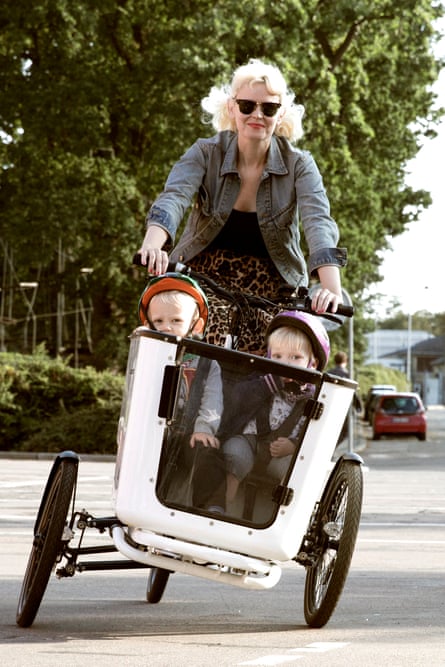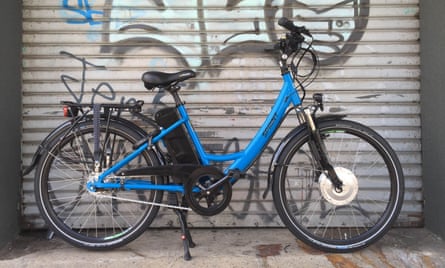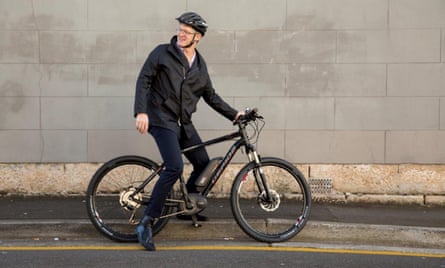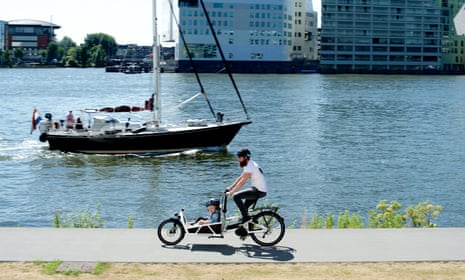They say there is nothing as zealous as a convert. As someone who last year joined the growing numbers of commuters who zoom into work by electric bike, I could not be more zealous.
I used to sneer at proud car owners, talking passionately about what their vehicle gave in kilometres per litre and other such metrics of performance. But I can now be found at traffic lights or outside the supermarket as I pack my pannier with shopping, merrily discussing the range, battery life and speed of my beloved bike with anyone who asks. And people do ask.
My daily Sydney commute is 13km each way, a fairly hilly journey to the city that takes me about 30 minutes versus an hour by bus on a bad day (and on my route, they are mostly bad days). As modes of transport go, it’s fast, cheap, green and enormous fun.
I ride an eZee Sprint (from $2,849), a model built for commuting. It’s a heavy bike, because of the battery it carries and its reassuring strength. Its motor is engaged by pedalling or using the throttle on the handlebar, and the level of power given by the motor can be adjusted on an interface pad.

The choice of five power levels allows cyclists to choose how much “assist” they want from the motor when pedalling. On a flat road or path, choosing level one will require a reasonable output from your legs, while level five will mean you’re flying along with no resistance at all.
You can sail to the top steadily when pedalling up a very steep hill on level five, expending some energy, but not enough to break a sweat or worry about running out of steam and having your bike stall and roll back down.
When it comes to recharging, the battery is removed from its bracket and plugged into a charger, rather like a large mobile phone charger, in a normal socket. It takes about three hours to fully charge, and yields about 30km (cycling on full power). The battery can be charged 1,000 times before it will need replacing.
E-bikes, or pedal-assist bikes as they are sometimes known, are dismissed by some cycling purists as being a cheat’s option. But to compare them with a regular bike is to miss the point.

The manager of Glow Worm Bikes, Sarah Baker, a long-time cyclist, says: “There’s a bit of a stigma about e-bikes among hardcore cyclists, but [they] need to be seen in context. It’s another form of cycling and surely these critics would prefer to have someone riding an e-bike to a petrol-powered car.”
Baker says the uptake for e-bikes is mainly from commuters and an increasing number of parents negating the horror of the school run by transporting kids on electric cargo bikes. And “old people love them”.
One self-described old person is Joan Kerridge, an 80-year-old who leads the Gentle Giants, a cycling group for seniors. Kerridge, from Sydney’s lower north shore, has been an avid cyclist for many years, but these days the city’s topography is a bit daunting, so she and several other Giants have swapped their push bikes for e-bikes.
“At our age you don’t get any faster but you get smarter,” she says. “Our group has a pretty slow pace, but when someone starts to struggle and doesn’t want to give up, many are going electric. Our oldest member is 86 and his cycling life has been extended by at least two years. Isn’t that wonderful?”
The head of the interest group Bicycle NSW, Ray Rice, says import figures are vague because the numbers for electric bikes, scooters and Segways are not separated. The whole sector, though, which is mainly e-bikes, has quadrupled over the past four years.

Rick Krassoi owns Eurocycles, a big importer and retailer of e-bikes, and the Bosch service partner supporting all bike shops in Australia that sell Bosch powered e-bikes.
Krassoi says by Bosch’s estimates there are about 3,000 of its motors on the road in Australia, and it projects that will double in a year. “A gross estimate of all brands is that there are 12,000 on the road.”
He says e-bike numbers are small here because of a lack of awareness (Bosch says more than 500,000 pedelecs were expected to be sold in Germany last year). “I think people don’t know they exist. We visit a lot of sustainability events and if people get a chance to ride one, they are usually converted.”
Asked if the cost, ranging from up to $10,000 for a top of the range cargo bike to $3,500 for a mountain bike, was a deterrent, Krassoi says it is negligible compared with cars. There are no insurance or registration costs, each battery charge costs less than 20 cents and you can park anywhere.
The argument that e-bikes are the lazy option negating the health benefits of cycling has a flip side too. Riding a pedal-assist bike using low power will elevate the cyclist’s heart rate consistently, without the sudden highs of taking on hills on a regular bike. E-bike owners are more likely to choose a ride over driving, even when their energy is flagging, because the potential for exhaustion is less. Reduced exertion is better than none at all.
The target demographic for e-bikes was originally people over 50, but the latest models are marketed at hip young action figures with a penchant for mountain biking. However, Krassoi says: “Most e-mountain bikes never see much dirt at all, but are used as commuters with slick tyres. The parallel is the dominance of SUV cars, which will likely never be taken off-road.”

The EN15194 European standard to which e-bikes must conform declares them in the same class as traditional bikes. Pedelecs (pedal assist bike without throttle) are allowed to have a motor of up to 250 watts (continuous output) but the motor must cut out when the speed reaches 25km/h or the rider stops pedalling. Bikes with a throttle can have only a 200-watt motor.
The New South Wales transport department says there are no plans to change the laws for e-bikes.
Bicycle NSW’s Ray Rice says one of the obstacles for e-bike users, as for all cyclists, is the lack of infrastructure in Australian cities. While the design and size of existing lanes is suitable for e-bike riders to use simultaneously with regular cyclists, “our bike lane networks are not up to scratch and there are many missing links in all our major cities. There are many great plans to improve the networks, but we need more will and more action to see them realised.”
Krassoi says: “E-bikes are a hybrid of human and electrical energy, working with perfect integration through the wizardry of sensors and robust electronics. They present a pragmatic solution to challenges in our modern urban environments, where ultimately we want to replace car trips with bike trips.”

Comments (…)
Sign in or create your Guardian account to join the discussion